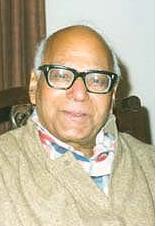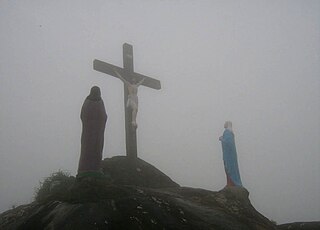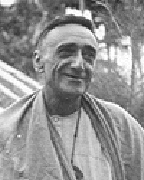
Ram Swarup, born Ram Swarup Agarwal, was an Indian author and one of the most important thought leaders of the Hindu revivalist movement. His works took a critical stance against Christianity, Islam and Communism.

Christianity and other religions documents Christianity's relationship with other world religions, and the differences and similarities.

Interfaith dialogue refers to cooperative, constructive, and positive interaction between people of different religious traditions and/or spiritual or humanistic beliefs, at both the individual and institutional levels. It is distinct from syncretism or alternative religion, in that dialogue often involves promoting understanding between different religions or beliefs to increase acceptance of others, rather than to synthesize new beliefs.
In the field of comparative religion, many scholars, academics, and religious figures have looked at the relationships between Hinduism and other religions.

Bede Griffiths OSB Cam, born Alan Richard Griffiths and also known by the end of his life as Swami Dayananda, was a British-born priest and Benedictine monk who lived in ashrams in South India and became a noted yogi. Griffiths was a part of the Christian Ashram Movement.
The term Dalit Christian is used to describe those who have converted to Christianity from Hinduism or Islam and are still categorized as Dalits in Hindu, Christian and Islamic societies in India, Pakistan and other countries. Hindu Dalits are referred to as "Harijans". 90% of Pakistani Christians are Dalits and over 42% of Indian Christians are Dalits, categorized thus by the greater societal practices of the region they live in.
Shuddhi is Sanskrit for purification. It is a term used to describe a Hindu religious movement aimed at the religious conversion of non-Hindus of Indian origin to Hinduism.

Raimon Panikkar Alemany, also known as Raimundo Panikkar and Raymond Panikkar, was a Spanish Roman Catholic priest and a proponent of Interfaith dialogue. As a scholar, he specialized in comparative religion.

Brahmabandhav Upadhyay was an Indian Bengali theologian, journalist and freedom fighter. He was closely attached with Keshub Chandra Sen, classmate of Swami Vivekananda and close acquaintance of Rabindranath Tagore.
The concept of God in Hinduism varies in its diverse traditions. Hinduism spans a wide range of beliefs such as henotheism, monotheism, polytheism, panentheism, pantheism, pandeism, monism, agnosticism, atheism and nontheism.

Abhishiktananda, born Henri Le Saux, was a French monk who, having moved to India in 1948 in search of a more radical form of spiritual life, adopted sannyasa in accordance with Indian tradition and became one of the pioneers of Hindu-Christian dialogue. Multiple contacts with prominent saints such as Sri Ramana Maharshi, Sri Gnanananda Giri and Sri H.W.L. Poonja, led him to profound advaitic experience as well as to final recognition of the truth of advaita during the last years of his life.

Kurisumala Ashram is a Trappist Monastery in Syro-Malankara Catholic Church in the Sahya Mountains in Kerala, India. Kurisu is the translation of the word cross into Malayalam, the language of Kerala; mala means mountain; ashram means monastery. Hence, the name describes the community of monks who practise austerity and live a strict monastic life on the mount of the Cross in the high hills of Kerala.

Francis Xavier Clooney is an American Jesuit priest and scholar in the teachings of Hinduism. He is currently a professor at Harvard Divinity School in Cambridge, Massachusetts.
Sara Grant, RSCJ was a British Indologist, Christian missionary, and one of the pioneers of interreligious dialogue in the twentieth century. She came to India in 1956, as a missionary and member of the Religious of the Sacred Heart of Jesus, became actively engaged in interreligious dialogue in India. In time, she became a leading figure in the inculturation movement that was started in India by Roman Catholic priest Fr Richard De Smet, SJ in the early 1970s, with whom she was closely associated with. Her association with Swami Abhishiktananda, further led to working on the Advaita Vedanta (Nondualism) teachings of Hindu philosopher Adi Sankara, as revealed in her spiritual autobiography, Towards an Alternative Theology: Confessions of a Non-dualist Christian (1991).
Saccidananda Ashram is a Benedictine monastery in Tannirpalli, India founded in 1950.
Thanneerpalli is a large village in karur district, Tamil Nadu, India. It lies on the road to Tiruchirapalli and about 1.5 miles from Kulittalai. According to the 1981 census it had a population of 7,429 people. It lies on the bank of the Kavery river and lies in an arid area with mangroves. Thanneerpalli has a notable fine temple and is known for the "Trinity from Thanneerpalli", who were the co-founders of Saccidananda Ashram, an ashram founded in the village in 1938.

Father Jules Monchanin, was a French Catholic priest, monk and hermit. He was an ardent proponent of Hindu-Christian interfaith dialogue. He is known for the being one of the "Trinity from Tannirpalli" along with Le Saux, and Griffiths who were the co-founders of Saccidananda Ashram, an ashram founded in the village of Tannirpalli in Tamil Nadu in 1938.

Kali Charan Banerjee (1847–1907), spelt also as Kalicharan Banerji or K.C. Banerjea or K.C. Banurji, was a Bengali convert to Christianity through the Free Church of Scotland, the founder of Calcutta Christo Samaj, a Calcutta lawyer, and a founding member of the Indian National Congress.
Jack Copley Winslow, also known by names John Copley Winslow or J.C. Winslow or John C. Winslow or Jack C. Winslow, was an English Society for the Propagation of the Gospel (SPG) missionary to Konkan and Pune, then-Poona—both part of then-Bombay Presidency. He was an evangelist, hymnist, and the founder of Christa Seva Sangh—interpreted as Community of the Servants of Christ or The Fellowship of the Servants of Christ and/or The Christian Fellowship of Service.
The Teape Lectures were established at Cambridge University in 1955. They form the major activity of the Teape Trust, created from an endowment made posthumously by William Marshall Teape. The object of the trust is 'The advancement of education by the provision of lectures on the relationship between Christian and Hindu thought and subject thereto the study of Christian and Hindu religious thought and the promotion of Christian-Hindu relations'.










